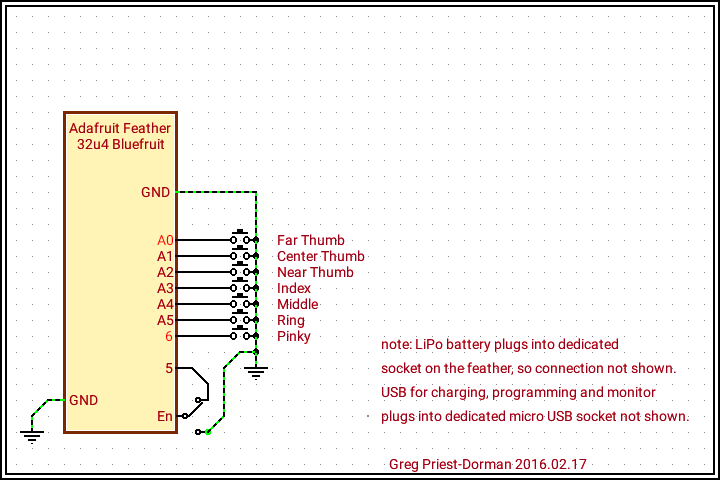Table of Contents
FeatherChorder
In late January of 2016 I began using an Adafruit Feather as the board powering my on hand chorder. There was an almost total code rewrite, so at that time the USB SpiffChorder became the BLE FeatherChorder. The reworked code for the feather was written with Charles Chen and is available on GitHub. (link below) There were some code issues that came down to this: it is important NOT to use the latest firmware for the nRF51822 chipset! Advancing beyond 0.7.7 seems to introduce an issue when reattaching to the host device (phone, computer, tablet, etc). Using the 0.7.7 firmware the device will automatically connect with it's host device and be a functional keyboard. Going beyond that and you need to regularly forget the device and redo pairing. I am going to continue to look into this, but the keyboard is stable and solid with firmware 0.7.7.
So, here is the FeatherChorder, a BLE (Bluetooth Low Energy) Chorder using the Adafruit Feather 32u4 Bluefruit LE
Please note, the connection to pin 5 is no longer needed. It was there to allow for a chord to trigger a hardware reset. This was a carry over from the pre-arduino days. The software reset on the arduinos and feathers has proven to be robust enough not to require this, so rather than the SPDT shown above connecting EN, pin 5, and GND, only SPST connecting EN to GND is now needed.
The advantage of using this board is that it has both the LiPo charger and the BLE transceiver built in, reducing the board count for the chorder from three to one. All that is required is to attach the keys and an on/off switch, plug in the battery, and then program it over a standard micro usb cable.
Code
Github page for the project: https://github.com/clc/chorder
Or, if you just want the zip archive of the latest build from gitub:
Download the Latest BTE Build
Thanks to Charles Chen for his work on this version!
For the USB version of the Featherchorder, use the above code, but replace FeatherChorder.ino with FeatherChorder_TinyUSB.ino below. The tinyusb version has been tested on the adafruit KB2040 (not a feather) and the adafruit ESP32-S3 feathers1)
Download the Latest USB Build 2025-03-26
Thanks to Zach Lash for his work on this version!
For a USB chorder you don't need the on/off switch unless you will have the keyboard connected at times you want to suppress chords from being sent.2)
Parts
- an adafruit feather 32u4 bluefruit for BLE or an adafruit KB2040 for a USB chorder.
- 7 keyswitches; I suggest Cherry Red MX switches3)
- BLE only: a small SPDT switch
- BLE only: a LiPo battery with 2-pin JST-PH connector; I like 350mA, 500mA is probably overkill.
- something to hold your keys, see other sections of this site for case ideas. It will work with the 3D Printer Files for Chorders.
The Chords
Once you grab a copy of the code you can find all the chords in the ChordMappings.h file. Change them as you see fit. They are the same as the chords I use on the spiffchorder plus one set of changes - I have added a bunch of android specific chords. Media events, Volume control and the like. I will add a chart here in the not too distant future. In the mean time, the ChordMappings.h file has them.

